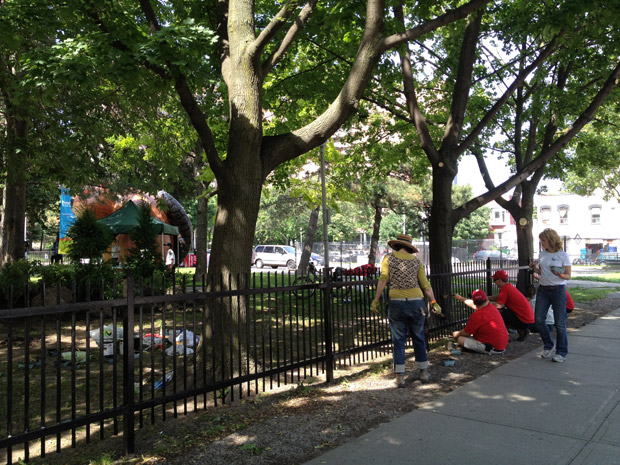TORONTO – In just one day, the neighbourhood of Moss Park has received a dramatic makeover.

Volunteers from the community joined forces between 9am and 5pm to build a new urban green space at a Toronto Community Housing apartment complex, at 275, 285, and 295 Shuter Street.
Residents of Moss Park, along with representatives from Coca-Cola, ParticipACTION, Parks Canada, Bienenstock Natural Playgrounds and Toronto Community Housing staff, built a park space that incorporates new seating areas, a soccer pitch, well-lit pathways and a community-managed vegetable garden.
The goal of the project was to revive a location that had lost its appeal as a safe and usable outdoor space after years of poverty and social issues in the area, and to increase activity and connectivity amongst the housing project residents.
On Friday, music played out of loud speakers as volunteers were hard at work, helping construct vegetable garden plots, painting fences and drawing the lines for a new soccer pitch.
The project is being praised by the federal government for integrating natural elements into the urban setting.
“The Moss Park Rejuvenation is providing the community with an outdoor space that connects them to the spirit of our national parks in an urban setting,” said the Hon. Peter Kent, Canada’s Environment Minister and Minister responsible for Parks Canada.
The project is also raising questions about a public-private partnership between the city and large corporations like Coca-Cola, whose branding could be spotted throughout the park.
Moss Park background
Moss Park has seen many changes since its illustrious beginnings.
Around 1830, wealthy businessman and politician William Allan built his estate on the land now home to Moss Park.
When Allan died in 1853, his son George – who would later go on to become mayor of Toronto in 1855 – divided up the land into plots, which were populated by Victorian homes.
In the 1960s, the Allan estate and surrounding Victorian homes were demolished to make way for public housing apartments.
Dotted with beautiful brick houses and mature trees, the streets in the Moss Park neighbourhood have also been characterised by crime and drugs over the years.
Poverty, health and safety have long been important issues for the area residents.
The area is home to numerous homeless shelters and some of the worst poverty in Toronto and has been characterized by many as downtrodden and dangerous.
Data from Statistics Canada in 2006 (the last year data of this type was available) showed Ward 28, which includes Moss Park, Regent Park and parts of St. Jamestown, had the highest poverty level in the city.
Forty-one per cent of Ward 28 residents in the 2006 census earned an income below Statistics Canada’s low-income cut off.
The community space on Shuter Street is just one in a series of changes coming to the neighbourhood, as the deep pits and cranes that characterise Toronto’s skyline creep closer each year.
Numerous condo projects are changing the cityscape of the Moss Park neighbourhood, including PACE Condos, a 35-storey tower at the corner of Dundas and Parliament and O2 Maisonettes at 102 Shuter Street.
Fourteen new affordable housing units are being built in the area as well, but some worry it’s not enough to keep a balance in the transforming neighbourhood.
Coun. Kristyn Wong-Tam, of Ward 27, says more needs to be done to ensure residents in places like Moss Park don’t get pushed out with gentrification.
“How do we ensure that we build more affordable housing and not less, and how do we not displace people?” said Wong-Tam at a community planning meeting in April.
“Pushing poor people out of a neighbourhood is not a solution for me, and I’m not interested in gentrification. I’m interested in empowering neighbourhoods, I’m interested in empowering residents.”


Comments